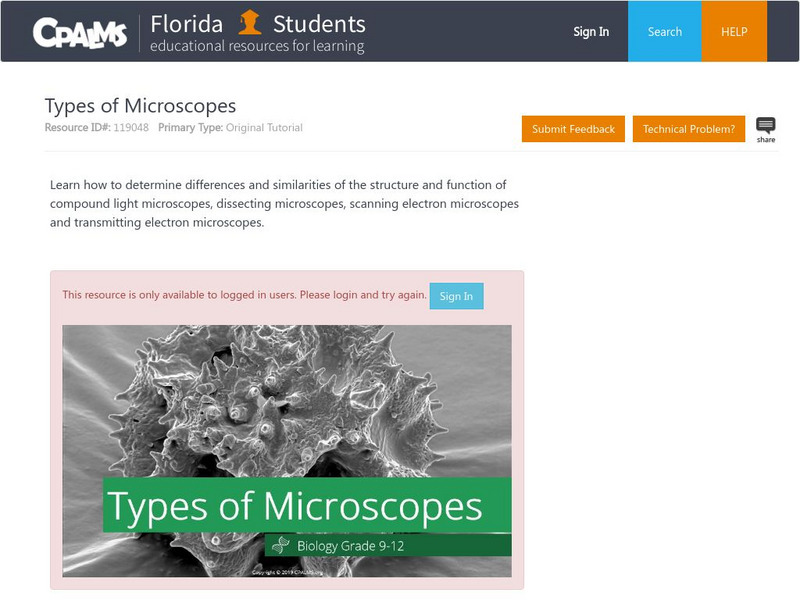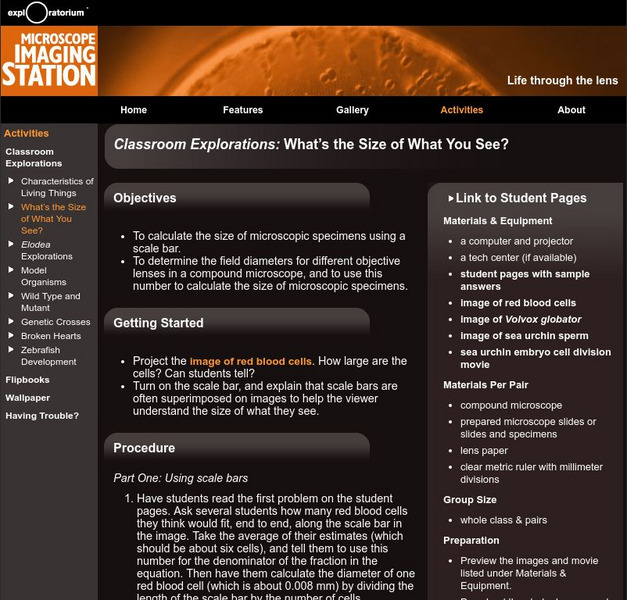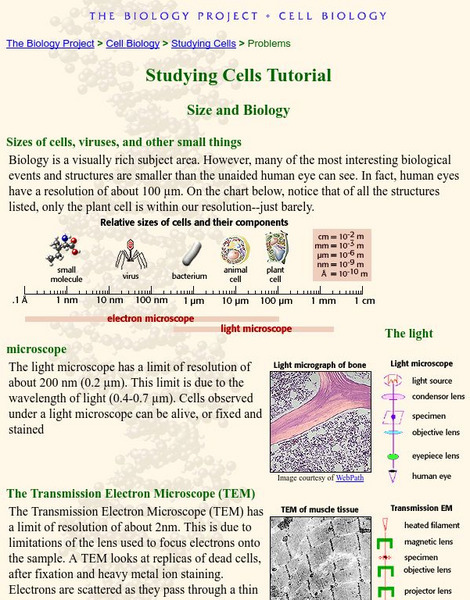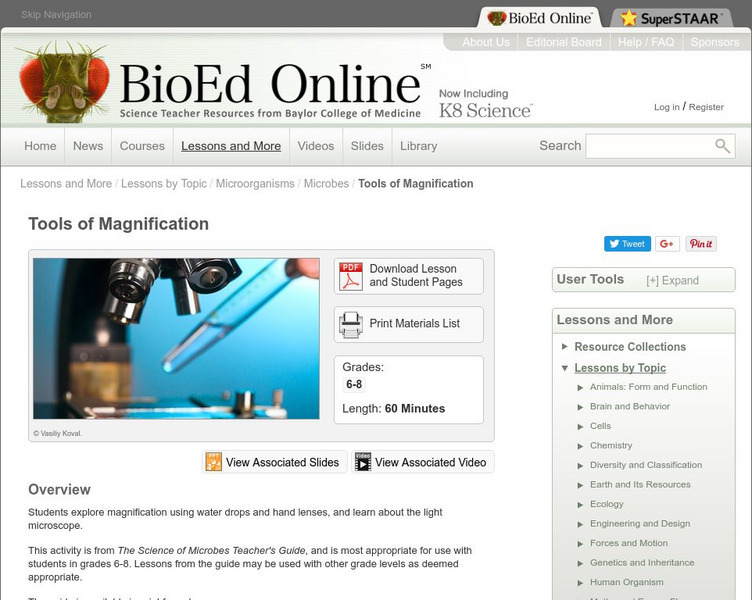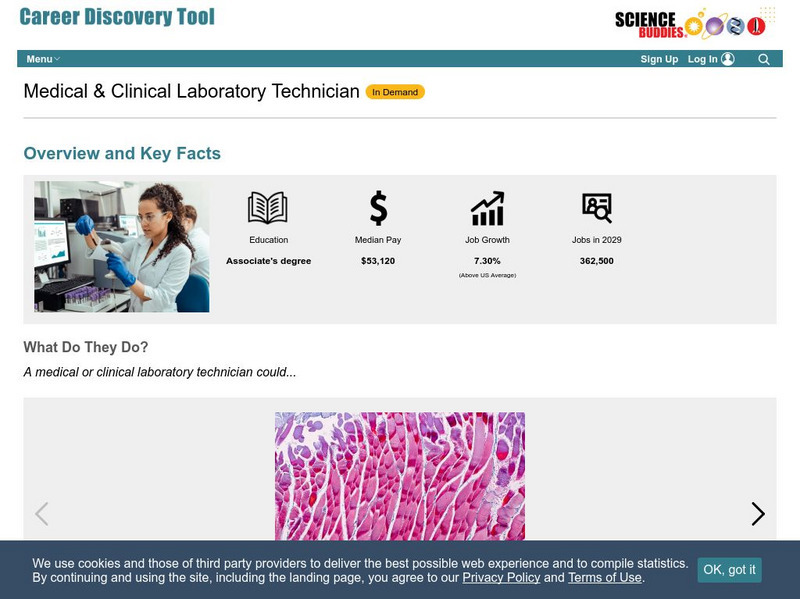Science Struck
Science Struck: Light Microscope vs Electron Microscope: A Comparison
Looks at the differences and similarities between a light microscope and an electron microscope. Discusses their structure, how images are formed, their resolution and magnification, how color is manifested, their portability, cost, and...
Science Struck
Science Struck: A Study of the Microscope and Its Functions
Uses illustrations with labels to complement a detailed examination of the parts and functions of a light microscope and an electron microscope.
Science Struck
Science Struck: Compound Microscope: Basics, Functionality, and Uses
Explains what a compound microscope is, the different parts, how it works, and what it is used for.
CPALMS
Florida State University Cpalms: Florida Students: Types of Microscopes
A program will help students determine differences and similarities of the structure and function of compound light microscopes, dissecting microscopes, scanning electron microscopes and transmitting electron microscopes.
Exploratorium
Exploratorium: Microscope Imaging Station: What's the Size of What You See?
In this instructional activity, you use microscope images to show how to use scale bars to measure very small things.
Colorado State University
Colorado State University: Gross and Microscopic Anatomy of the Large Intestine
Describes the structures associated with the large intestine. Gives a good illustration of the microscopic anatomy of the large intestine.
OpenStax
Open Stax: Anatomy & Physiology: Microscopic Anatomy of the Kidney
Students learn about the renal structures that conduct the essential work of the kidneys and cannot be seen by the naked eye.
Other
University of Bristol, Uk: Minerals Under the Microscope
In this geology course, students learn about the use of the polarizing microscope, the primary tool for examining the structure of mineral samples such as cleavage, density, fracture, color, and the like.
Colorado State University
Colorado State University: Gross and Microscopic Anatomy of the Stomach
Describes the human stomach in terms of its structural components.
Florida State University
Florida State University: Translational Microscopy
With this interactive tutorial, you can view cholesterol, pesticide, ibuprofen, and other samples under a microscope. You can adjust the focus, intensity, and zoom in on the object. Requires Java.
BioEd Online
Bio Ed Online: The Science of Microbes: Magnifying and Observing Cells
In this activity, middle schoolers create slides of plant cells and observe them under a microscope. The lesson and PowerPoint slides can be downloaded. The included instructional video on cell observation is 20 min. 44 sec.
BioEd Online
Bio Ed Online: The Science of Microbes: Observing Different Microbes
Learners prepare slides of and examine three types of common microbes using a light microscope, recording what they observe. The lesson plan and a set of PowerPoint slides can be downloaded. An accompanying instructional video is 22 min....
NPR: National Public Radio
Npr: From Microscopes to Large Scale Sculpture
This site is about the microbiologist turned artist, Kendall Buster turns what she sees under the microscope into oversized sculptures.
University of Arizona
The Biology Project: Studying Cells Tutorial: Size and Biology
Get an overview of light microscopes, scanning electron microscopes and transmission electron microscopes. There is also a brief description of sizes for several microscopic objects.
BioEd Online
Bio Ed Online: The Science of Microbes: Tools of Magnification
The invention of magnifiers that allow us to see things that are otherwise invisible to us has revolutionized science. In this lesson, young scholars use several types of magnifiers to investigate magnification, and record their...
TED Talks
Ted: Ted Ed: Visualizing Hidden Worlds Inside Your Body
How do we see things too small to be detected by the human eye? What about things inside our own bodies? Dee Breger uses a scanning electron microscope to give us a glimpse of images including blood clots, thyroid glands, and lungs with...
Famous Scientists
Famous Scientists: Antonie Van Leeuwenhoek
Learn about the life and work of Antonie van Leeuwenhoek, best known for his work on the improvement of the microscope, and considered to be the first microbiologist.
Other
Dennis Kunkel Microscopy: Microscopy
A description of the three different types of microscopy: light, transmission electron, and scanning electron
Science Buddies
Science Buddies: Career Profile: Medical & Clinical Laboratory Technician
Find out about the work done by the medical laboratory technician. It involves examining both body fluids and cells under the microscope or with specialized computer equipment, analyzing the results, and forwarding that information on to...
Science Buddies
Science Buddies: Career Profile: Microbiologist
Microbiologists spend their careers peering through microscopes in their study of microorganisms. They have plenty to look at since these are Earth's most common life-forms. Science Buddies outlines the education requirements as well as...
Science Buddies
Science Buddies: Using Laser Pointer to Measure Data Track Spacing on C Ds, Dv Ds
You've probably noticed the colorful patterns "reflecting" from the shiny surface of a CD disk. What you are seeing is actually diffraction of white light, and the rainbows of color are diffraction patterns. In this project you'll learn...
Science Buddies
Science Buddies: Caffeine and Heart Rate: A Pharmacological Study Using Daphnia
In this project, water fleas (Daphnia magna), a semi-transparent freshwater crustacean, are used to study the effects of caffeine on heart rate. You do not have to learn how to take a crustacean's pulse though, because you can actually...
Other
University of Western Australia: Integumentary System
A resource for advanced anatomy and physiology classes. It contains information on the integumentary system, the epidermis, the dermis, hair, sebaceous glands, and sweat glands. Microscopic images are included.
Other
National Institute for Basic Biology: The Plant Organelles World
This web resource provides basic information about structure and function of plant organelles through a large interactive cell drawing, as well as many opportunities to explore further. Links lead the learner to several short movies of...
Other popular searches
- Parts of a Microscope
- Compound Microscopes
- Label Compound Microscope
- Dissection Microscopes
- Microscope Cheek Cells
- Digital Microscope
- Microscope Lab
- Biology Lab Microscopes
- Scanning Electron Microscopes
- Cheek Cells and Microscopes
- Lesson Plan on Microscopes
- Lenses and Microscopes

